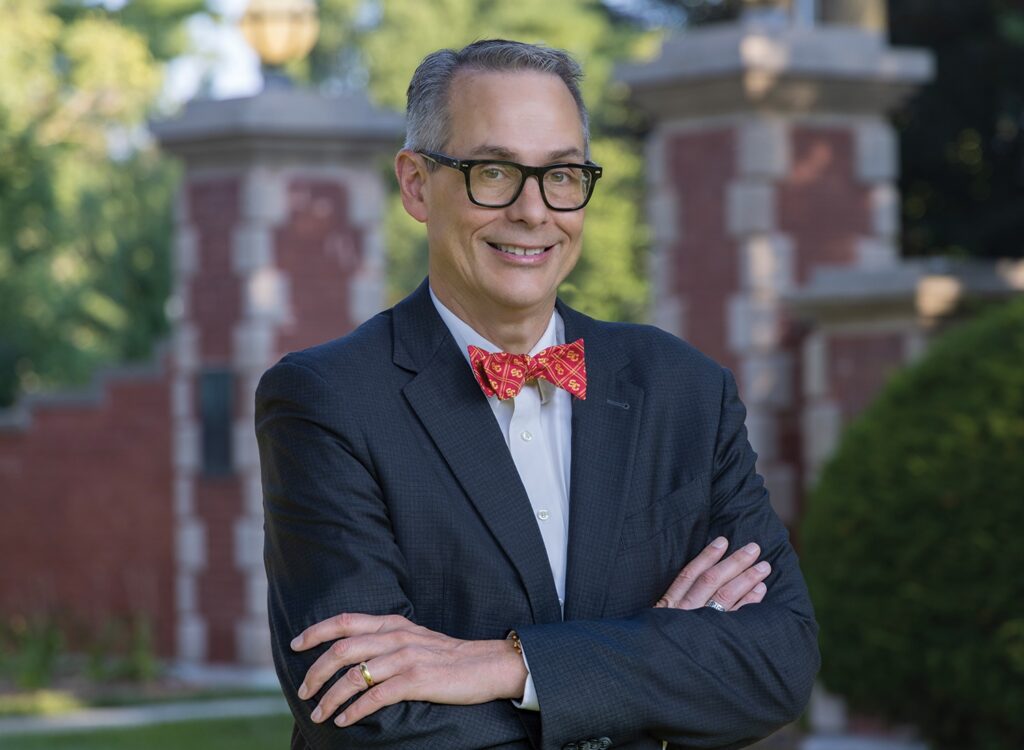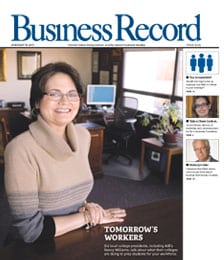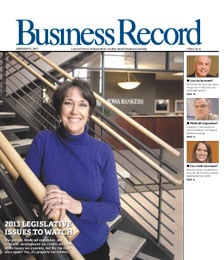The long road ahead

The seemingly endless string of brake lights snaking down Iowa Highway 141on weekday mornings has become all too familiar for commuters from Grimes, Granger, Polk City and other outlying communities. But as residential and commercial growth continues, they know their drive into work won’t begin to ease anytime soon.
Some community leaders are listening, however, and developing plans that may ease traffic congestion and, in the process, advance development in that region of Greater Des Moines.
“We all know the 141 interchange [with Interstate 35/80] is deficient, that traffic volumes are making it a very difficult interchange to travel,” said Urbandale City Manager Bob Layton. He and other leaders from Urbandale, Johnston, Grimes and Polk County have spent years studying the interchange and ways to create “an improved level of service so we can get short term relief.”
Of course, traffic congestion is not isolated to that corner of Polk County. As neighborhoods swell, commercial developments emerge and land values climb, city and county leaders have been forced to take a forward-thinking approach in considering the area’s infrastructure and what deficiencies must be addressed before existing problems spiral out of control.
There’s a crying need for a traffic study on the west side of Polk County and the east side of Dallas County,” said Polk County Supervisor E.J. Giovannetti. “You can drive from Adel to 63rd Street in Des Moines, and if you don’t se a traffic problem, there’s something wrong with your eyesight.”
The Des Moines Area Metropolitan Planning Organization has identified a dozen or more spots where interstate highway interchanges may need to be built to accommodate the increased traffic resulting from residential and commercial growth.
“I believe we still have work to do on the long list of interchanges to figure out what we need for this freeway system over the next 20 years,” said MPO Executive Director Tom Kane.
But building a $25 million interchange is easier said than done. Cities and counties must battle through funding proposals, land negotiations and one study after another in a process that typically costs millions before the first steel beam is ever erected.
CRUNCH TIME
The Iowa Highway 141 interchange with Interstate Highway 35/80 has become one of the main points of contention. Some fear the interchange cannot accommodate additional growth, and Giovannetti said reconstructing the interchange could cost $150 million or more. Even then, traffic congestion would likely remain an issue.
“As a practical matter, you have to attack that problem peripherally,” he said.
Urbandale, Johnston and Grimes, led by Polk County, have proposed the construction of a full diamond interchange at 100th Street and a half-diamond interchange at Meredith Drive, with a southbound entrance ramp and northbound exit ramp. Both are included in the MPO’s long-range plan and are in Phase 2 of the Interstate Justification Report required by the Iowa Department of Transportation that determines the proposal’s need and practicality.
“They both serve economic development corridors for Urbandale,” Layton said.
In January, Urbandale city leaders met to discuss those projects, as well as a proposal to modify the 86th Street interchange, with Congressman Leonard Boswell, who encouraged them to apply for funds to be used for further study. The 100th Street proposal received $1.2 million for design work and right-of-way acquisition through the federal transportation reauthorization bill approved by Congress in July.
The Meredith Drive project did not receive funding, though city and county leaders believe the project is still a viable solution to the Highway 141 issue.
“We’ve had substantial development along the east side (of Interstate 35/80) and now significant ground is open on the west side,” Layton said. “As we see more intensive office development along Meredith, there is a concern about bottlenecking.”
OPENING TO DEVELOPMENT
In addition to traffic relief, city, county and business leaders believe new interstate interchanges in northwestern Polk County would improve access to hundreds of acres of undeveloped land, creating opportunities for economic development for all stakeholders.
“One of the things we recognize in the entire northwest area is that there has been tremendous growth in the residential as well as the business and commercial side,” said Mike Carver, a commercial real estate broker with Grubb & Ellis/Mid-America Pacific LLC. “In addition to what growth we’ve seen, there’s still a substantial amount of undeveloped ground in that corridor. And one of the huge challenges you have as land continues to develop, whether it is office or retail, is just handling the traffic flow.”
A study conducted in 2004 found that a 100th Street interchange would dramatically increase the number of developed acres of land and taxable value within the 9 square miles bordered by Northwest 70th Avenue on the north, Meredith Drive on the south, 86th Street on the east and 128th/James Street on the west. In 2004, that area contained about 600 developed acres of land with a taxable value of more than $165.7 million. The study projects that an interchange would increase that to more than 2,500 developed acres with a taxable value of more than $1 billion.
“It will be a very important infrastructure improvement to help speed development in that part of Polk County,” said Carver, whose work with Grubb & Ellis/Mid-America Pacific includes the Northpark Business Center, under development north of Interstate 35/80 between 86th and 100th streets.
Near both proposed interchanges, some developers have avoided a wait-and-see approach and instead have moved forward with office park projects, convinced that the demand for those developments outweighs accessibility issues.
Greg Judas, president of K.C. Holdings Inc., believes West Park, his company’s 75-acre office park at Northwest 54th Avenue and Northwest 100th Street, will be successful even without a 100th Street interchange, but if one were built, that would allow the park to be “marketed to more regional companies.”
Realty Marketing Group, a subsidiary of R&R Realty Group, announced plans in July to build Paragon Office Park along Meredith Drive just west of the interstate. Mark Rupprecht, president of Realty Marketing Group, said the growing population in northwestern Polk County serves as a strong labor pool for companies looking to build in Paragon. But an interchange would also improve the project’s marketability, particularly with 8,000 people projected to work at the office park.
“The interchange is going to be beneficial because it’s going to provide better access to the existing road system and may even accelerate the improvements to some of those local roads,” he said.
Johnston city leaders have fully supported the effort to build an interchange at 100th Street, which serves as a corridor on the western edge of the community. But the city is also moving forward with plans for development and is hardly slowed by the project’s uncertainty. City Administrator Jim Sanders said much of the land along 100th Street has been platted with plans for commercial and residential development.
“I think the development is going to happen anyway,” he said. “But having the interchange would help in getting those really moving forward and would help the area develop quicker.” Sanders believes much of the land along 100th Street would be built out before an interchange is complete, but that an interchange could serve as an incentive for businesses looking to build in a convenient location.
FUNDING STRUGGLES
In Ankeny, construction is under way on a $22.7 million project to reconstruct parts of the East First Street interchange with Interstate 35 to better accommodate the increased traffic counts resulting from the city’s growing population.
City leaders believe more access to Interstate 35 will be needed in the future as development continues northward, and have proposed a $21.1 million interchange at and Northeast 36th Street that they believe will ease the congestion that is expected to worsen in the years ahead.
But some argue that traffic levels on East First Street and Oralabor Road have not yet reached a critical level that would warrant an additional interchange, and the interchange at Corporate Woods Drive, completed in October 2004, has already eased some congestion on Oralabor.
“We really need to have the interchange at Northeast 36th Street probably by 2020 or 2030 at the latest to avoid having all of our traffic from that part of Ankeny traveling to the south, creating a level of service that would be low,” said City Manager Carl Metzger. “We have some time and don’t have to do anything tomorrow, but we need to see if we can make it become a reality before we have those traffic problems.”
The project has been included in the MPO’s long-range plan, and an Interchange Justification Report is expected to be complete by the end of the year.
But several issues persist that Giovannetti said have put this project further behind other interchange proposals in Greater Des Moines. The federal government has already appropriated $5.1 million to the city Interstate 35 interchange improvements, either for East First Street or Northeast 36th Street, which he said puts the city at a disadvantage when federal transportation funds are allocated in the near future. Metzger said the city simply does not have the financing in place to make a Northeast 36th Street interchange happen right now, and said it could be five years or more before all of the pieces are assembled.
Kane of the MPO said Ankeny would likely have to negotiate with the Iowa Department of Transportation in regard to the state’s rest stop, which is near Northeast 36th Street. The entrance and exit ramps for the interchange could create a hazard for vehicles using that rest stop or the interchange.
Unlike northwestern Polk County, plans for an interchange are not coming on the heels of commercial development. The area around Northeast 36th Street and the interstate is surrounded by a city-owned golf course, some residential development and farmland. Metzger said most of the development that would result from an interchange would be east of the interstate or northward development that the city anticipates happening regardless.
Developers have not stepped forward with formal interest in the properties, he said, because of uncertainty of the uncertainty over whether the interchange will actually be built in the near future.
“Obviously any time you start talking about an interchange people ask questions,” Metzger said. “But when we say it’s several years off, it’s too far off for developers to do any effective planning.”
NORTH AND SOUTH CONNECTORS
Polk County and the city of Des Moines are considering two roadway projects that could potentially change the face of the city. The first, known as the Southeast Connector, would extend Martin Luther King Jr. Parkway east across the Des Moines River, first to Southeast 14th Street and eventually to U.S. Highway 65.
Acting City Manager Rick Clark said Des Moines has begun to allocate money in its budget for the project in addition to accumulating funds from local, state and federal sources, including $7.2 million from the federal transportation reauthorization bill.
But a larger point of contention rests with a proposal for an interchange at Interstate 35/80 and Morningstar Drive/Northwest 26th Street. Conceptual plans call extending Morningstar south to connect with Martin Luther King Jr. Parkway. Clark said the project, which received $1.02 million from the federal transportation reauthorization bill, has received a lot of interest, but that a consensus has not been reached, largely due to environmental and land-use issues. Construction of the roadway would cut through neighborhoods on the North Side of Des Moines, thereby driving up the cost even further.
“I think most if not everybody would agree that we need an interchange there and an interchange will occur there,” Giovannetti said. “Sooner or later we’ve gotta bite the bullet. We need a way to get from I-80 to downtown Des Moines. But by the time they decide that, my grandkids will be gone.”
THE ROAD AHEAD
In Dallas County, planning continues on a proposed interchange proposal at Alice’s Road/105th Street, a project that has been in Waukee’s comprehensive plan since 1992. It received $3 million in the past three years from the federal government, but failed to receive additional funds in this year’s transportation bill. The city has planned for commercial, residential and office park development in the corridor, but full build-out of that area could take up to 15 or 20 years, city leaders said.
The MPO and other city and county leaders have considered larger corridor studies for Iowa Highways 44 and 141, also due to residential growth in those outlying communities. Polk County, Urbandale, Johnston and Grimes were denied a $300,000 funding request to be used for a Highway 141 corridor study, Kane said.
“We supported asking for planning funds for the 141 study, because in our modeling, Highway 141 is probably our most troubling issue right now,” Kane said. “The whole corridor has traffic congestion problems right now.”
Mark Rupprecht and Realty Marketing Group are eyeing conceptual plans to relocate Highway 44 and place it at the northern edge of Paragon Office Park to intersect with 128th Street. The cities and county were denied a $1 million request for a Highway 44 corridor study, but Kane said that project or the Highway 141 corridor project could receive funding later this year through fiscal 2006 appropriations.
Kane cautioned that even the projects that have been earmarked for funds are not guaranteed to receive the full amount appropriated with the bill. Funds are disbursed over a five-year period, and a budget crunch could put those in jeopardy.
“The broader question is, what impact are Hurricane Katrina and the cost of gasoline going to have on these major transportation projects?” Giovannetti asked.







